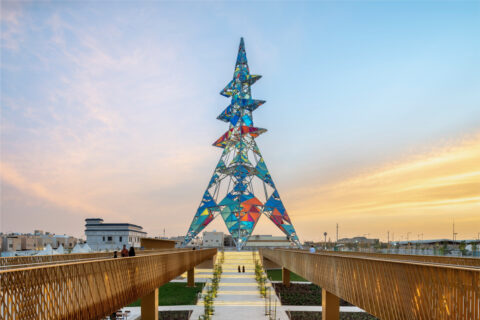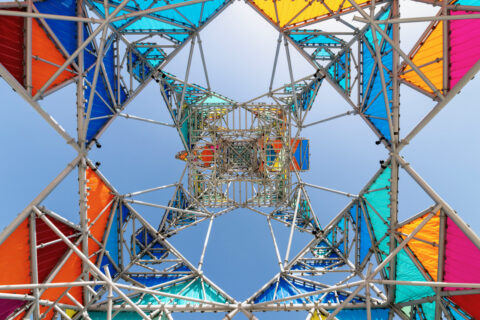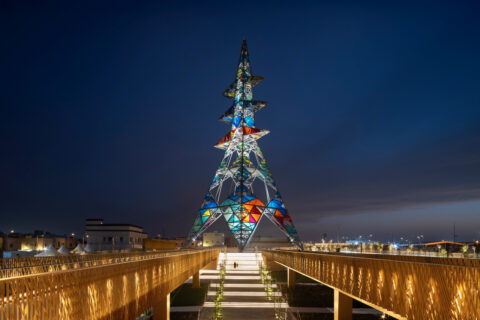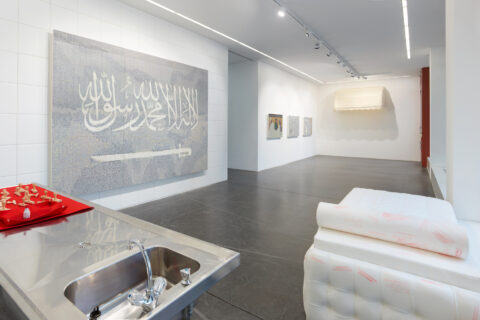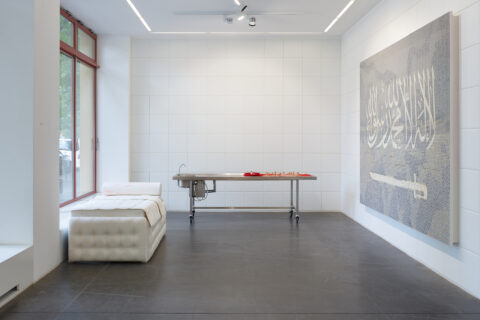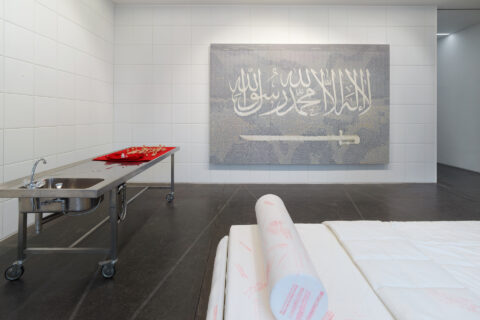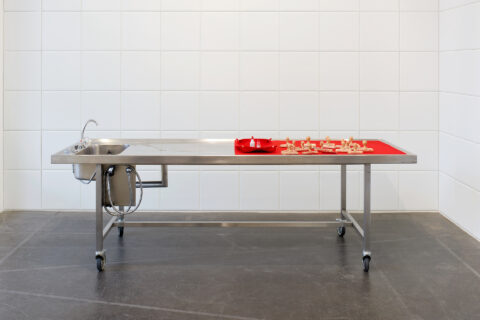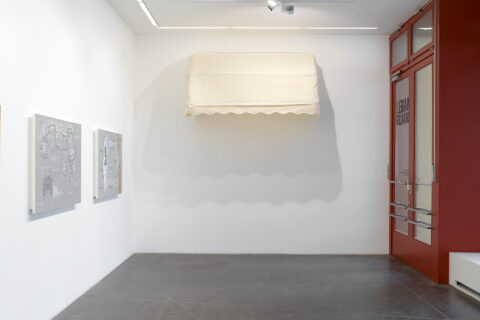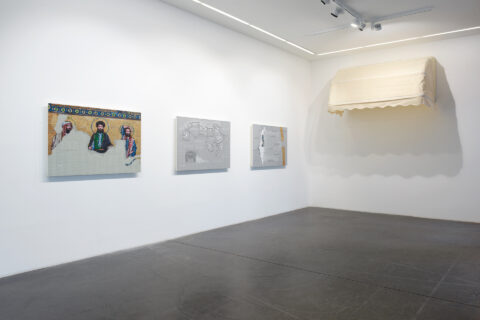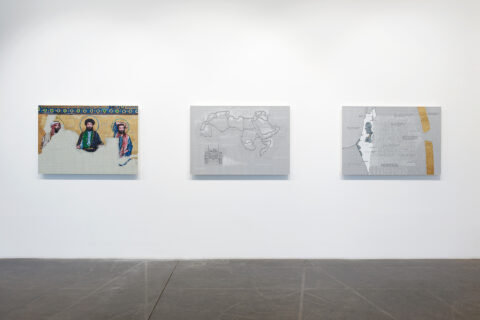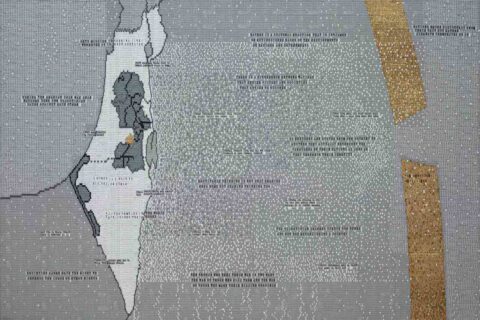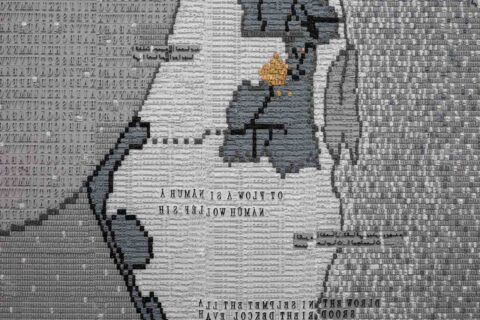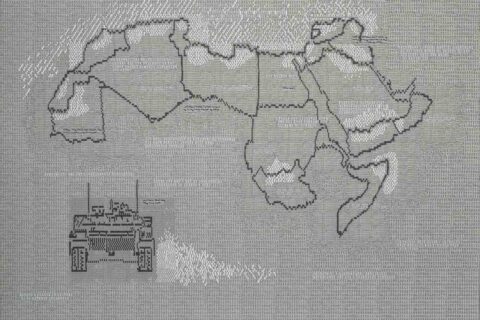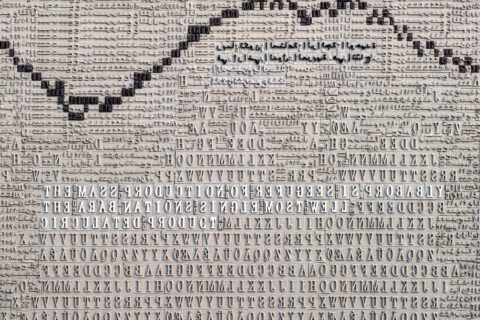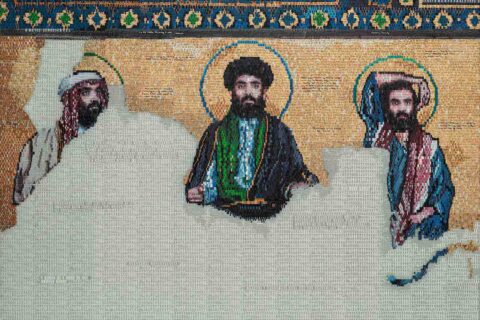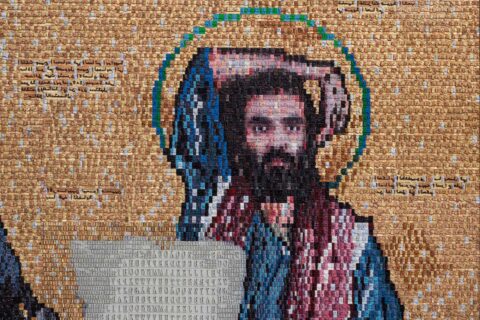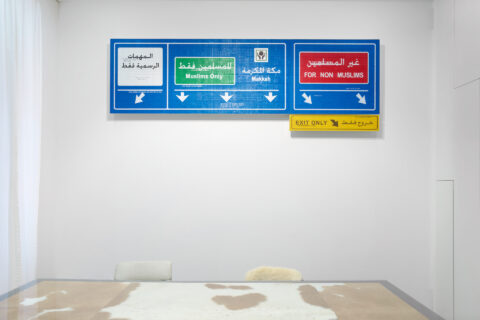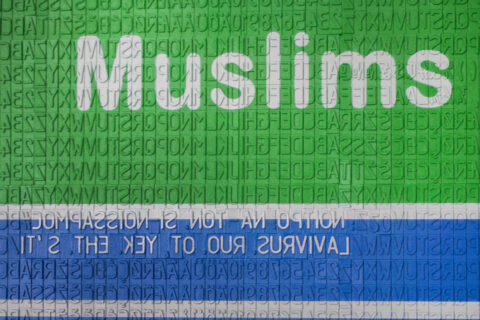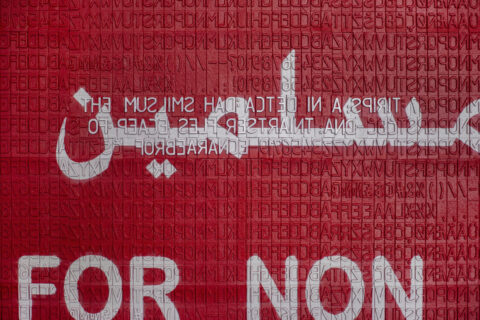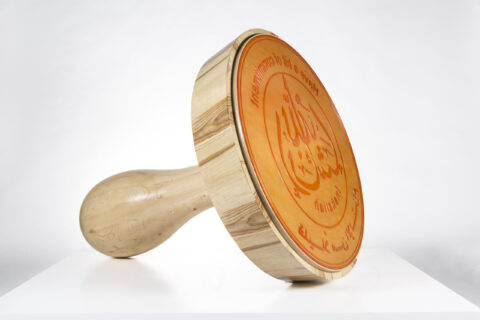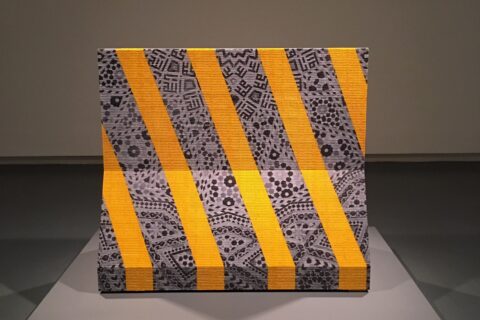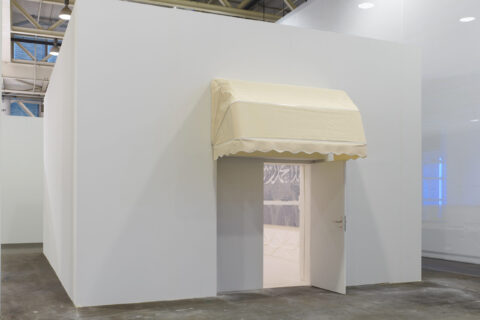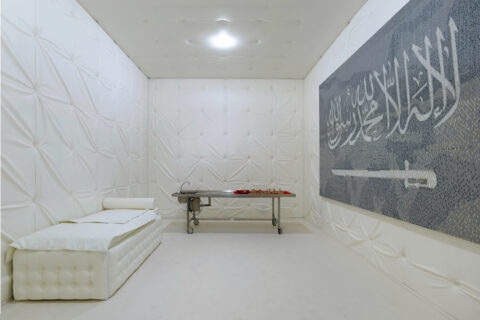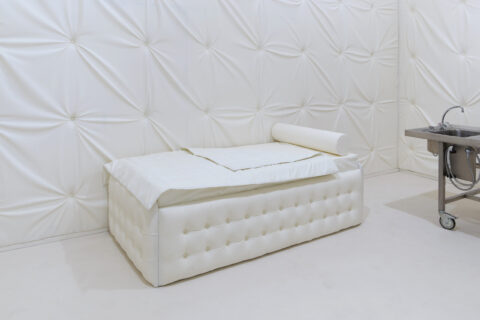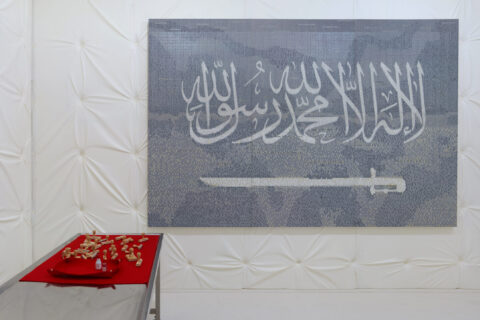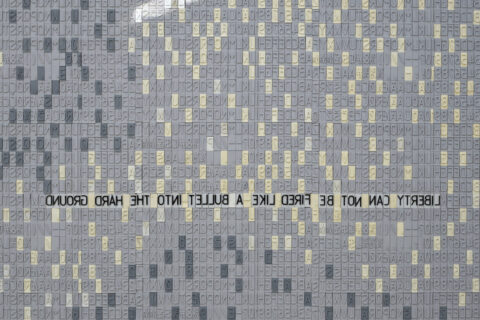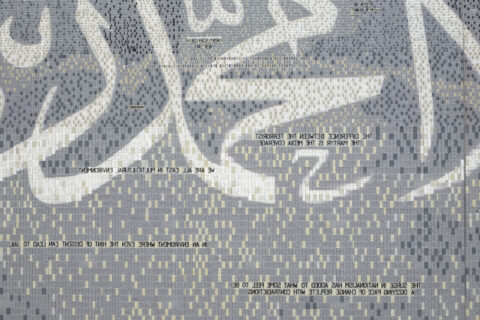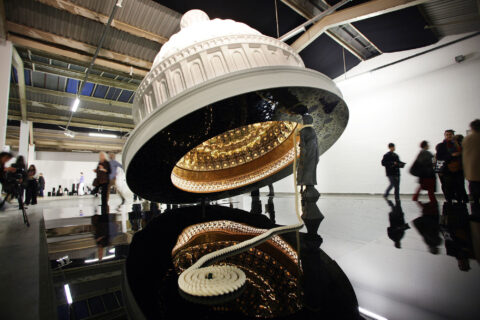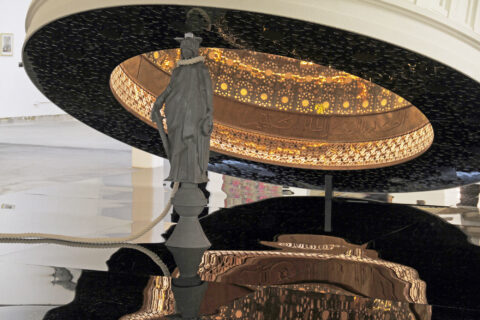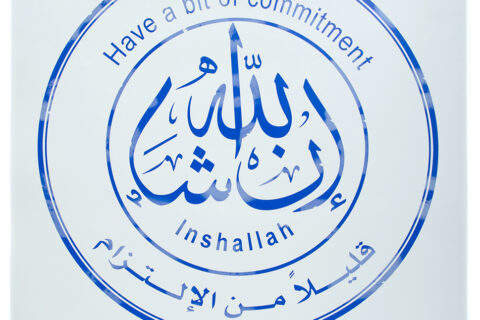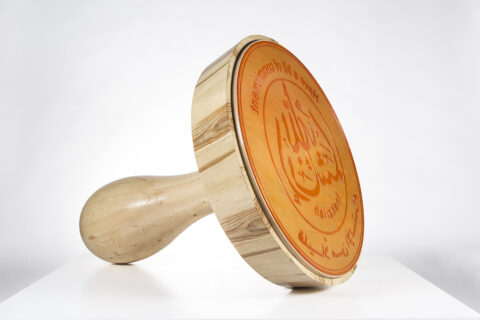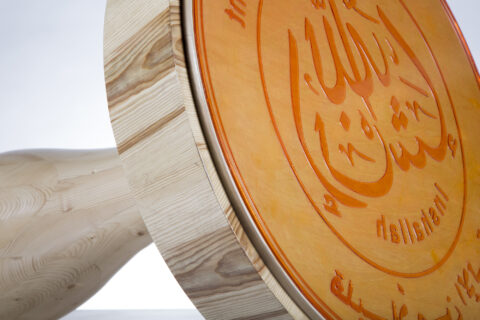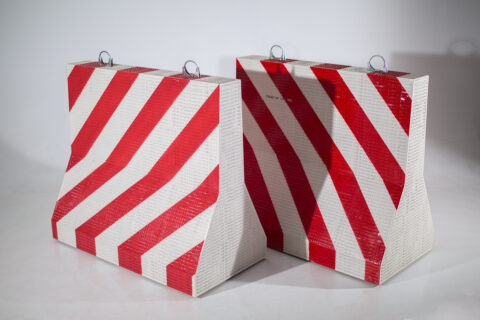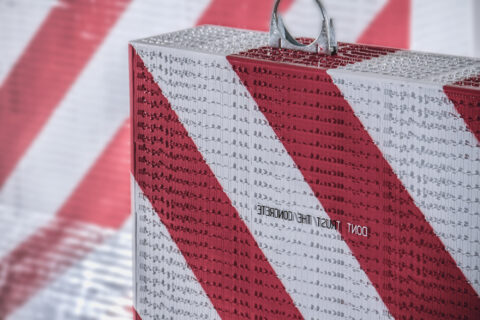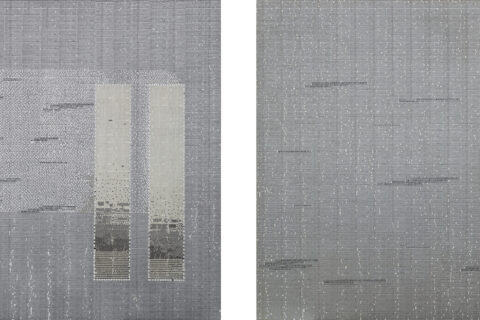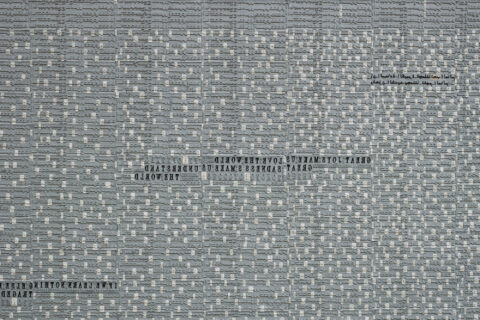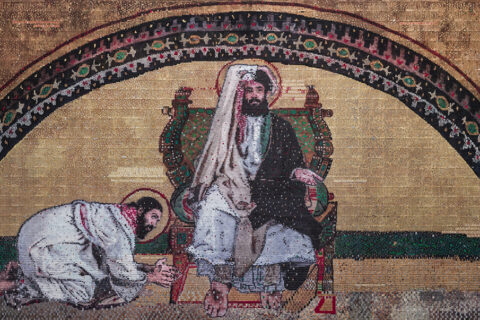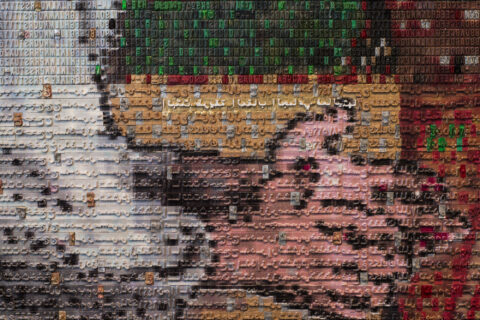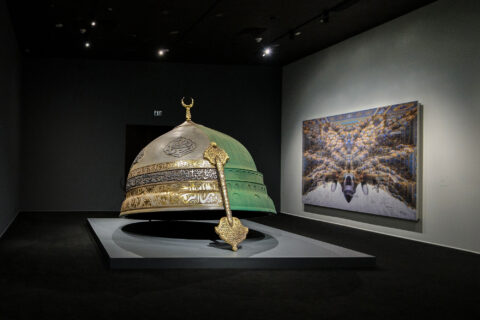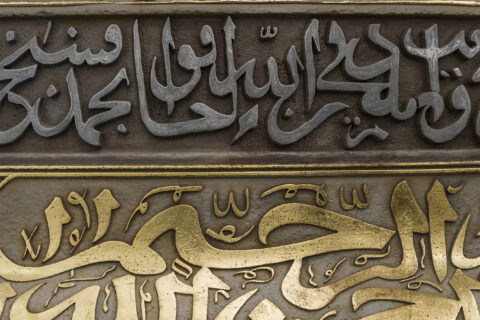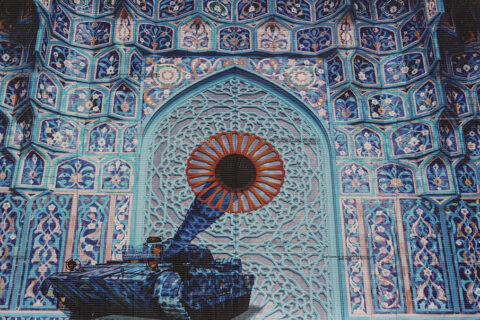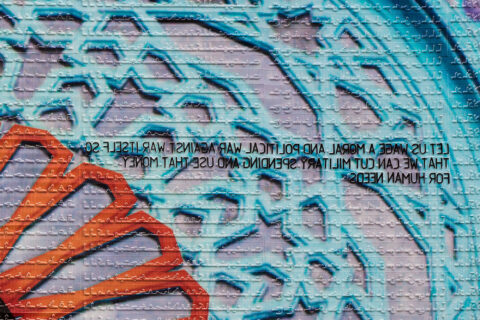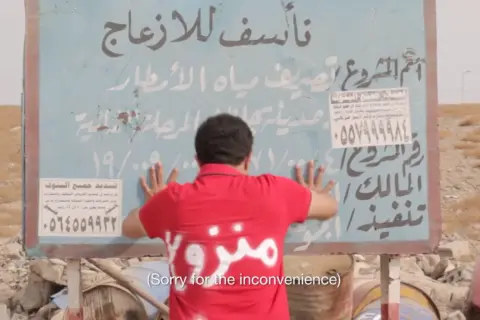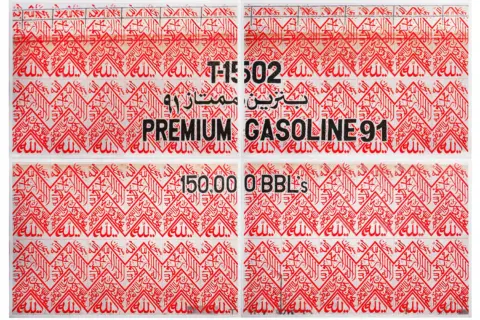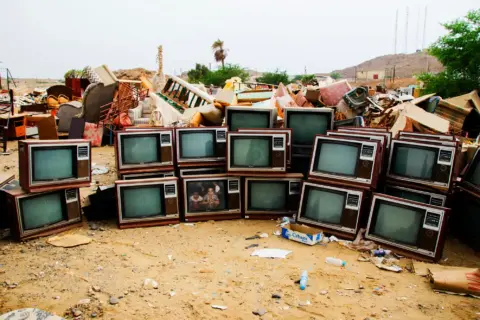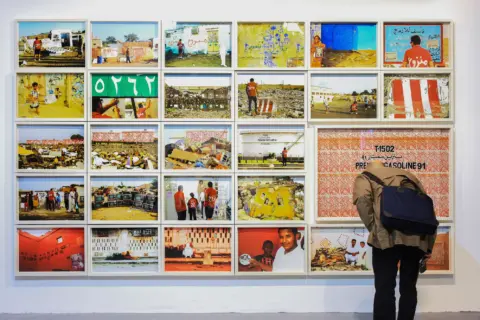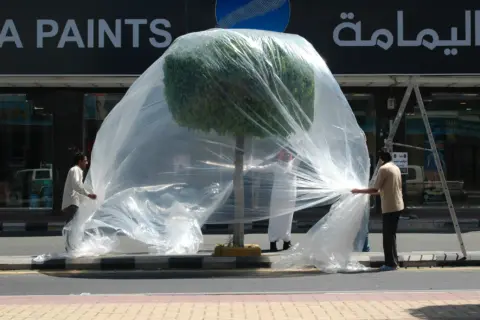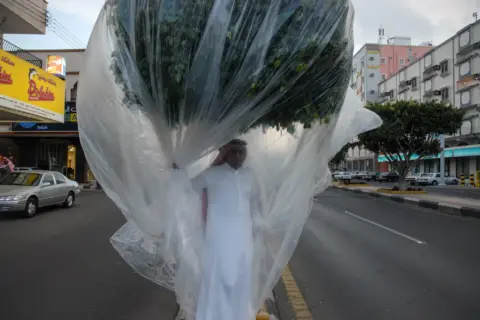Abdulnasser Gharem
Hospitable Thinking, 2020
„Smart Obedience / Kluger Gehorsam“
Installation view
Galerie Nagel Draxler, Berlin 2020
Hospitable Thinking, 2020
„Smart Obedience / Kluger Gehorsam“
Installation view
Galerie Nagel Draxler, Berlin 2020
Personal Holocaust, 2020
„Smart Obedience / Kluger Gehorsam“
Installation view
Galerie Nagel Draxler, Berlin 2020
Personal Holocaust, 2020
„Smart Obedience / Kluger Gehorsam“
Installation view
Galerie Nagel Draxler, Berlin 2020
Prosperity without growth II, 2020 (Detail)
„Smart Obedience / Kluger Gehorsam“
Installation view
Galerie Nagel Draxler, Berlin 2020
Prosperity without growth II, 2020 (Detail)
„Smart Obedience / Kluger Gehorsam“
Installation view
Galerie Nagel Draxler, Berlin 2020
Road to Makkah, 2019
„Smart Obedience / Kluger Gehorsam“
Installation view
Galerie Nagel Draxler, Berlin 2020
Photo: Simon Vogel
Abdulnasser Gharem
„Road to Makkah“, 2019
Digital print and lacquer paint on rubber stamps on aluminum
104 x 305 cm
Abdulnasser Gharem
„Road to Makkah“, 2019
Digital print and lacquer paint on rubber stamps on aluminum
104 x 305 cm
„The Stamp (Inshallah)“, 2008
Hand carved oversized wooden stamp with embossed rubber face
95 x 95 x 120 cm
Edition of 8 + 3 AP
„Concrete Block IV“, 2018
Rubber stamps and industrial lacquer paint on 9 mm plywood board
100 x 111 x 54 cm
„The Safe“, 2019
Insulated quilted synthetic leather walls and door, stainless steel basin, plastic awning, stamps
600 × 400 × 400 cm
236.2 × 157.5 × 157.5 in
Installation view
Art Basel Unlimited 2019
Photo: Simon Vogel
„The Safe“, 2019
Insulated quilted synthetic leather walls and door, stainless steel basin, plastic awning, stamps
600 × 400 × 400 cm
236.2 × 157.5 × 157.5 in
Installation view
Art Basel Unlimited 2019
Photo: Simon Vogel
„The Safe“, 2019
Insulated quilted synthetic leather walls and door, stainless steel basin, plastic awning, stamps
600 × 400 × 400 cm
236.2 × 157.5 × 157.5 in
Installation view
Art Basel Unlimited 2019
Photo: Simon Vogel
„The Safe“, 2019
Insulated quilted synthetic leather walls and door, stainless steel basin, plastic awning, stamps
600 × 400 × 400 cm
236.2 × 157.5 × 157.5 in
Installation view
Art Basel Unlimited 2019
Photo: Simon Vogel
Abdulnasser Gharem
„The Safe“, 2019
Insulated quilted synthetic leather walls and door, stainless steel basin, plastic awning, stamps
600 × 400 × 400 cm
236.2 × 157.5 × 157.5 in
Installation view
Art Basel Unlimited 2019
Photo: Simon Vogel
Abdulnasser Gharem
„The Safe“, 2019
Insulated quilted synthetic leather walls and door, stainless steel basin, plastic awning, stamps
600 × 400 × 400 cm
236.2 × 157.5 × 157.5 in
Installation view
Art Basel Unlimited 2019
Photo: Simon Vogel
„Capital Dome“, 2012
Wood and high density polystyrene dome with copper and wood; hand carved statue with steel frame; natural rope
400 x 400 x 500 cm
The Capitol Dome installation is a 13-foot scaled-down replica of the Capitol Dome in Washington D.C. which is held up by Thomas Crawford’s 19th century statue of the armed goddess of Freedom. The inner-sides of the dome are decorated with intricate hand-crafted Islamic motifs, which resemble an interior of a mosque. The forced amalgamation of Islamic geometry and neo-classical architectural styles is intended to question the splice of democratic values on Arab culture and its future sustainability.
Gharem uses the statue of Freedom to invite the audience to consider what ‚freedom‘ represents. Crawford’s statue of Freedom bears a sword and shield. While maternal and welcoming she is at the same time well-armed and outwardly dynamic.
The key element in this work however lays in the positioning of the dome. It has been set up to resemble a crude trap. ‘Freedom has become a lure. I was inspired by my childhood when I used to make traps like this for birds using upturned baskets, with a trail of food leading towards it. In the same way, many Saudis are drawn to democracy but we don’t know what is inside. Perhaps it is like a mosque? Perhaps something else.’ (The artist quoted in The Washington Post, 8 October 2012).
Gharem’s dome sits on shinny oil-like black tiles, which represent the flammable nature of this commodity and serves as a powerful reminder of exporting diametrically opposed ideologies on to traditional cultures.
Abdulnasser Gharem
„Capital Dome“, 2012
Wood and high density polystyrene dome with copper and wood; hand carved statue with steel frame; natural rope
400 x 400 x 500 cm
„Inshallah Stamp Print“, 2012
Handprinted Silk Screen Print on Somerset Tub Paper
150 x 120 cm
„The Stamp (Inshallah)“, 2012
Wood and embossed rubber face
95 x 95 x 120cm
Conceived in 2008 and executed in 2010.
Abdulnasser Gharem’s „The Stamp (Inshallah)“ (2012) takes a satirical view on bureaucracy in the Arab world. Each day in Saudi Arabia thousands of stamps are slammed down onto a mosaic of unrelated papers. These stamps tend to be gathered up in the pudgy palms of bureaucrats, officials, policemen, soldiers and others. They articulate an unconscious and collective imprimatur, pronouncing what is right, what is acceptable, and which is the right path. This form of bureaucracy is exemplified in the field of banking, in which Islamic banks position themselves as moral alternatives to conventional banks. The work challenges our idea of formal bureaucratic approval of Islamic certification, and the power implied within a stamp and to what end that object is used.
Abdulnasser Gharem, *1973
The Saudi Arabian artist Abdulnasser Gharem is known for his highly political and highly sensitive works of art, which achieve the balancing act of creating an open platform in a restrictive society and intelligently and subversively push the limits of the possible. In a recently published interview in the New York Times, he says: “That is your role as an artist, to bring out the option that the politician can’t say and that the religious man can’t say,” – “You bring out the solutions that people can’t say.” The “Restored Behaviour” series that he calls Stamp Paintings are painted on a bed of thousands of individual rubber letter stamps. The stamp, synonymous with bureaucracy as the medium to legitimate individual identity or to formalize interactions, is reconfigured here to question, pointedly. In another interview Gharem says that he is “concerned with our understanding of and the relationship to the premise that we trust in ideas and structures that are presented as absolute, to safety and immovability, but also to bureaucracy and the authorisation of its process.” (Universes in Universe / Nafas Art Magazine, November 2016). Gharem’s works of art show very impressively that art, rather than any political action, is the effective medium for infiltration.
Abdulnasser Gharem
„The Stamp (Inshallah)“, 2012
Wood and embossed rubber face
95 x 95 x 120cm
Conceived in 2008 and executed in 2010.
„Concrete Block II“, 2014
Rubber stamps and industrial lacquer paint on 9 mm Plywood board
120 x 100 x 54 cm
Concrete Block is a bold attempt to critique the security backlash in the seething cauldron of his homeland. And his work is all the braver, given the reactionary nature of the politics he’s resisting: both terrorism and autocracy.
His giant alabaster roadblocks are suggestive of the concrete barriers springing up around embassies, major hotels and other perceived targets everywhere in the world. They are, in turn, redolent of other concrete „facts on the ground“ that have arisen in recent history; for instance, the perimeter wall Israel has built to keep out the Palestinians, and by extension, the Berlin Wall that was an iron curtain dividing Eastern Europe from the West, and that came crumbling down with much of communism in 1989.
Making up the surface of Gharem’s relief are hundreds of embossed impressions from his official Saudi army identification: the rubber stamp he uses countless times each day, day in day out, to validate the endless security documents, intelligence documents, government orders and classified paperwork that cross his desk.
Abdulnasser Gharem
„Concrete Block II“, 2014
Rubber stamps and industrial lacquer paint on 9 mm Plywood board
120 x 100 x 54 cm
„Pause II“, 2016
Lacquer paint on rubber stamps on aluminum
160.5 x 401 cm
Gharem’s personal reaction to the terrorist attacks of September 11, 2001, have laid the foundation for much of his artistic output, however, Pause is the work most closely concerned with the destruction of the World Trade Center. For Gharem, like most of us, witnessing the collapse of the Twin Towers on television was one of those shocking moments that seems to make the earth stand still or pause. When he later found out that two of the hijackers were classmates he wondered why they had chosen that horrific path while he, who had been given the same education, elected another. This expressive “stamp painting” is Gharem’s response.
On the left panel of the diptych are two solid rectangles seemingly rendered in shades of gray but, upon closer inspection, formed of tiny rubber letter stamps in Arabic and English and painted in black and white. The pair of rectangles signifies the digital symbol for “pause” as well as the Twin Towers, which look like ghostly after-images. An incomplete yellow arch–resembling a golden rainbow—straddles the diptych and draws our eyes back to the center. To underscore the visual connection with 9/11, Gharem has embedded within the composition twenty-seven short quotations formed of stamps painted black and written in reverse. On the far, left just to the right of the golden arch, he offers these words from Sandy Dahl, wife of Flight 93 pilot Jason Dahl, “If we learn nothing else from this tragedy, we learn that life is short and there is no time for hate.”
Abdulnasser Gharem
„Pause II“, 2016
Lacquer paint on rubber stamps on aluminum
160.5 x 401 cm
„Prosperity Without Growth“, 2017
Digital print and gold and color paint on rubber stamps on aluminum
120 x 240 cm
The artist Abdulnasser Gharem has become famous for his elaborately crafted “stamp-paintings”, as he calls them. He often heads for the processes that divide people, such as #political or #religious structures, in order to make it clear that it is about the unity of religions and the unity of all people in their diversity.
This painting is about the #interweaving of computer games and the structures that have grown in a society, such as that of religion, for example. If you look closely, you can see small, colourful pixelated dots that remind you of the surface of computer games. Gharem uses the image to express that computer games or the media in general have a stronger influence on opinion forming than education or religion.
His messages are mirror-inverted and interwoven into the images.
As an artist, he is interested in using his art as an aesthetic medium and not as an instrument. Man and his constitution is at the centre of his reflections, irrespective of his origin and religion.
Abdulnasser Gharem
„Prosperity Without Growth“, 2017
Digital print and gold and color paint on rubber stamps on aluminum
120 x 240 cm
„Hemisphere“, 2017
179 x 300 cm
Gharem has produced other dome sculptures, but this work, his most recent version, pre- sents an amalgam of two distinct forms to create the cupola: a mosque dome and a late Islamic–style warrior’s helmet. The title of the work is intended to suggest two halves that form a whole, as in the human brain with its left and right hemispheres, the former governing logic and the latter creativity. In the sculpture, the right half is based on the distinctive green dome of the Mosque of the Prophet in Medina, Saudi Arabia, which is the second holiest site in Islam, after the Kaaba in Mecca. Expanded many times over, the mosque’s dome was constructed in the early nineteenth century. The left side of the sculpture is patterned on an Iranian helmet inscribed with verses from the Qur’an, dat- ing to the eighteenth or nineteenth century, and probably intended for ceremonial and parade wear rather than for actual battle. The two halves of the dome are separated by an appropriately enlarged and inscribed nasal piece—the projecting bar on a helmet cov- ering the nose and protecting the center of the face. The comingling of the dome and the helmet in a single sculpture is meant to allude to the dichotomy inherent in most faiths—a message of peace and supplication versus the types of political and sectarian concerns that sometimes lead to violence.
Abdulnasser Gharem
„Hemisphere“, 2017
179 x 300 cm
Abdulnasser Gharem
„Camouflage III“, 2017
Digital print and lacquer paint on rubber stamps on aluminum
In four parts, each: 240 x 480 cm
Gharem frequently uses Islamic architectural settings in his work. Here he employs an Iranian mosque as the backdrop for this monumental “stamp painting,” which depicts an army tank (a common sight for Gharem, a lieutenant colonel in the Saudi Arabian army) with a giant orange daisy protruding from its canon. The flower and the colorful tile decoration of the mosque façade belie and even disguise the deadly nature of the armored vehicle. For the artist, this form of camouflage represents his own critique of theocracies that prey on sincere religious beliefs by promoting a message of intolerance toward adherents of other faiths. For LACMA’s audience, the combination of weapon and flower may be reminiscent of some of the antiwar imagery from the Vietnam War era; this powerful work perhaps takes on a new meaning once transplanted to American soil.
Abdulnasser Gharem
„Camouflage III“, 2017
Digital print and lacquer paint on rubber stamps on aluminum
In four parts, each: 240 x 480 cm
Biography
ABDULNASSER GHAREM
geboren / born 1973 in Khamis Mushait, Saudi Arabia
lebt und arbeitet / lives and works in Riyadh, Saudi Arabia
EDUCATION / AUSBILDUNG
1992 graduation from King Abdulaziz Military Academy, Riyadh, Saudi Arabia
1993 Leader Institute, Riyadh, Saudi Arabia
1995-2003 Lieutenant Colonel in the Saudi Arabian army
2003 Study of Fine Arts at Al-Meftaha Arts Village, Abha, Saudi Arabia
2013 Founding of Gharem Studio – non-profit arts organization offering artist residencies
ÖFFENTLICHE SAMMLUNGEN / PUBLIC COLLECTIONS
The British Museum, London, UK
V&A Museum | London, UK
Los Angeles County Museum of Art, California, USA
Palazzo Grassi, Venice, Italy
Greenbox Museum, Amsterdam, Holland
The Saudi Arabian Ministry of Culture & Information, Saudi Arabia
BASMOCA: Basma Al Sulaiman Museum of Contemporary Art, Jeddah, Saudi Arabia
The Barjeel Art Foundation, Sharjah, UAE
Nadour Collection, Germany
The Jameel Foundation
The Farook Collection
The Farjam Collection
Kamel Lazaar Foundation
EINZELAUSSTELLUNGEN (AUSWAHL) / SOLO EXHIBITIONS (SELECTION)
2022
"Hospitable Thoughts", Marc Straus Gallery, New York, USA.
2020
"Smart Obedience / Kluger Gehorsam", Galerie Nagel Draxler, Berlin.
2018
"Subversive Forms of Social Sculpture" (with Heimo Zobernig), Sharjah Art Museum, UAE.
2017
"Abdulnasser Gharem: Pause", LACMA, Los Angeles, USA.
2014
"The Awakening", Ayyam Gallery, Dubai, UAE.
2013
"Edge of Arabia", Ayyam Gallery, London, UK.
"Abdulnasser Gharem", Side by Side Gallery, Berlin, Germany.
2010
"Restored Behaviour", XVA Gallery, Dubai, UAE.
2006
"The Path", King Fahd Art Village, Abha, Saudi Arabia.
2004
"The White Tongue Who Speaks Slowly", King Fahad Art Village, Abha, Saudi Arabia.
"Who Keeps Watching the Sun (Sunflower field)", Death Mattered – Attileh, Jeddah, Saudi Arabia.
2003
"Mute", Attileh, Jeddah, Saudi Arabia.
"UN Inspector", Attileh, Jeddah, Saudi Arabia.
GRUPPENAUSSTELLUNGEN (AUSWAHL) / GROUP EXHIBITIONS (SELECTION)
2022
"The Mouth is for Speaking", WE ARE AIA | Awareness in Art, Zurich, CH.
2021
"Glastress Boca Raton", Boca Raton Museum of Art, Boca Raton, Florida, USA.
2019
"New Glass Now", The Corning Museum of Glass, Corning, NY.
"The Safe", Art Basel Unlimited, Basel.
2017
"Desert to Delta: Contemporary Saudi Art in Memphis", Art Museum of University of Memphis, TL, USA.
"Memories of a Journey Hajj", Sheikh Zayed Grand Mosque, Abu Dhabi, UAE.
"Cities of Conviction: Contemporary Saudi Art in Salt Lake City", Utah Museum of Contemporary Art, Salt Lake City, UT, USA.
"EPICENTER X: Contemporary Saudi Art Detroit", Arab American National Museum Dearborn, MI, USA.
"Glasstress", Palazzo Franchetti, Venice, Italy.
2016
"Phantom Punch: Contemporary Saudi Art in Lewiston", Bates College Museum of Art, Lewiston, Maine, USA.
"Generat#ion", Minnesota Street Project, San Francisco, California, USA.
"Gonzo Arabia: Contemporary Saudi Art in Aspen", Boogie's Retail, Aspen, Colorado, USA.
"Parallel Kingdom", Station Museum of Contemporary Art, Houston, TX, USA.
"Illumination, New Contemporary Art at the Louisiana", Louisiana Museum of Modern Art, Humlebaek, Denmark.
2015
"Saudi Art Contemporary", Chalet Saqqarah, Gstaad, Switzerland.
"Ricochet", Asia House Gallery, London, UK.
2014
"View fron inside: Contemporary Arab Photography", FotoFest, Houston, Texas, USA.
"Word and Illumination", Le Meridien Medina Hall, Madinah, Saudi Arabia.
2013
"Arab Contemporary", Louisiana Museum of Modern Art, Humlebaek, Denmark.
"A Generation In Waiting", Side by Side Gallery, Berlin, Germany.
2012
"Light from the Middle East: New Photography", V & A; Albert Museum, London, UK.
"La voce delle immagini", Palazzo Grassi, Venice, Italy.
"#COMETOGETHER", Edge of Arabia, London.
"Arab Express: The Latest Art From the Arab World", Mori Art Museum, Tokyo, Japan.
"Porta dell”Oriente", Roma Contemporary, Italy.
"Bending History", Katara Galleries, Doha Qatar.
"Hajj, Journey to the Heart of Islam", British Museum, London, UK.
"Edge of Arabia", Al Furusia Marina, Jeddah, Saudi Arabia.
Contemporary Istanbul, Turkey.
2011
"Political Patterns", ifa-Galerie, Berlin, Germany.
"The Future of a Promise: Contemporary Art from the Arab World", Magazzini del Sale, 54th Venice Biennale, Italy.
"The Bravery of Being Out of Range", Athr Gallery, Jeddah, Saudi Arabia.
"The New Middle East", Willem Baars Projects, Amsterdam, Netherlands.
"Edge of Arabia Dubai: TERMINAL", Building 9, Gate Village, Dubai International Financial Centre, Dubai, UAE.
"Uppers & Downers", Traffic, Dubai, UAE.
"Nujoom: Constellations of Arab Art from The Farjam Collection", The Farjam Collection @ DIFC, Dubai, UAE.
"I Don’t Need Your Money Honey All I Need is Love", Traffic, Dubai, UAE.
2010
"Edge of Arabia Istanbul: TRANSiTION", Sanat Limani, Antrepo 5, Trophane, Istanbul.
"Opening the Doors: Collecting Middle Eastern Art", Abu Dhabi Art, UAE.
"CAVE: Contemporary Arab Video Encounter", Maraya Arts Centre, Sharjah, UAE.
"Emerging Asian Artists", Gwangju Biennale, South Korea.
"Edge of Arabia Berlin: Grey Borders/Grey Frontiers" Soho House, Berlin, Germany.
"Fuck Ups, Fables and Fiascos", Galerie Caprice Horn, Berlin, Germany.
"Edge of Arabia World Tour Launch", Global Competitiveness Forum, Riyadh, Saudi Arabia.
"Taswir: Pictorial Mappings of Islam and Modernity", Martin Gropius-Bau, Berlin, Germany.
2009
"The 28th Annual Exhibition", Gulf Fine Arts Society, Sharjah, UAE.
"Edge of Arabia Venice", Palazzo Polignac, 53rd Venice Biennial, Venice, Italy.
2008
"Edge of Arabia London: Contemporary Art from Saudi Arabia", SOAS Brunei Gallery, University of London, UK.
2007
"Still Life: Art, Ecology and the Politics of Change", Sharjah Biennial 8, UAE.
2006
"Son of Aseer", Al-Meftaha Arts Village, Abha, Saudi Arabia.
2004
"Shattah", Atelier Gallery, Jeddah, Saudi Arabia.
PROJECT
2025
"The Arts Tower", Sports Boulevard, Riyadh, Saudi Arabia
Selected Press
CATALOGUES
Jameel, Porter, King, Stapleton, Al-Turki. Edge of Arabia: Contemporary Art from Saudi Arabia (London: Booth Clibborn, 2012)
Porter, Venetia. Hajj, journey to the heart of Islam (London: Harvard University Press, 2012)
Hemming, Henry. Abdulnasser Gharem: Art of Survival (London: Booth-Clibborn, 2011)
Lazaar, Lina and Downey, Anthony. The Future of a Promise (London: Ibraaz, 2011)
ARTICLES
2019
Freies Denken lehren, Deutschlandfunk Kultur,
Basciano, Oliver: "Who are the regional artists exhibiting at Art Basel this year?", The National, June 11, 2019.
Proctor, Rebecca Anne: "10 of the Buzziest Artists at Art Basel 2019", Galerie Magazine, June 14, 2019.
Bloch, Werner: "Ein steriler Ort des Schreckens", Zeit Online, 15. Juni 2019.
Heim, Christoph: "An dieser Klagemauer scheiden sich die Geister", Basler Zeitung, 14. Juni 2019.
Simon, Stefan: "Messe für die Superreichen", Südkurier, 13. Juni 2019.
Russeth, Andrew: "Art Basel’s Unlimited Section: By the Numbers", Artnews, June 14, 2019.
Proctor, Rebecca Anne: "Highlights From Art Basel: 14 Middle Eastern Artists", Harper's Bazaar Arabia, June 19, 2019.
Gropp, Rose-Maria: "Das Schaufenster zur Welt", Frankfurter Allgemeine, 14.Juni 2019.
Lorch, Catrin: "Im Limbo", Süddeutsche Zeitung, 14. Juni 2019.
Buesing, Nicole und Klaas, Heiko: "Kunst zwischen laut und leise", Dare, 13. Juni 2019.
Brown, Kate: "A Saudi Artist Is Debuting a Daring New Work About Murdered Dissident Journalist Jamal Khashoggi at Art Basel", Artnet, June 11, 2019.
Batycka, Dorian: "Imagining the Last Moments of Murdered Journalist Jamal Khashoggi", Hyperallergic, June 27, 2019.
Saudische Künstler schaffen sich Freiraum, Süddeutsche Zeitung, January 11, 2019.
